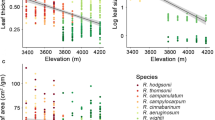Summary
Leaf longevities were determined for 16 species of evergreen shurbs (Ericaceae and Empetraceae) at different habitats at three latitudes (c. 47°, 55–58° and 68°N) in central and north Europe to determine whether any general trends exist in variation in leaf longevity within and among species. Among these species and sites, mean leaf longevity varied between 1.4 and 3.8 seasons, which is similar to the values reported for other evergreen shrubs, but shorter than for many evergreen conifers. Consistent differences in leaf longevity were found when comparing latitudes (ignoring altitude and habitat type): longevities were longer at 68°N than at the two lower latitudes. No consistent trends were found among species within altitudes.
Similar content being viewed by others
References
Aerts R (1989) Plant strategies and nutrient cycling in heathland ecosystems. PhD Thesis, University of Utrecht
Beadle NC (1966) Soil phosphate and its role in molding segments of the Australian flora and vegetation with special reference to xeromorphy and scleromorphy. Ecology 47:992–1007
Bell KL, Bliss LC (1977) Overwinter phenology of plants in a polar semidesert. Arctic 30:118–121
Berendse F, Aerts R (1987) Nitrogen-use-efficiency: a biologically meaningful definition? Funct Ecol 1:293–296
Chabot BF, Hicks DJ (1982) The ecology of leaf life spans. Annu Rev Ecol Syst 13:229–259
Chapin FS III (1980) The mineral nutrition of wild plants. Annu Rev Ecol Syst 11:233–260
Chapin FS III, Shaver GR (1985) Individualistic growth response of tundra plant species to environmental manipulations in the field. Ecology 66:564–576
Diamantoglou S, Mitrakos K (1981) Leaf longevity in Mediterranean evergreen sclerophylls. In: Margaris NS, Mooney HA (eds) Components of Productivity of Mediterranean-Climate Regions—Basic and Applied Aspects. Junk, The Hague, pp 17–19
Diemer M, Körner Ch, Prock S (1992) Leaf life spans in wild perennial herbaceous plants: a survey and attempts at a functional interpretation. Oecologia 89:10–16
Ewers FW, Schmid R (1981) Longevity of needle fascicles of Pinus longaeva (Bristlecone Pine) and other North American pines. Oecologia 51:107–115
Flower-Ellis JGK (1980) Diurnal dry weight variation and dry matter allocation of some tundra plants 1. Andromeda polifolia L. Ecol Bull (Stockholm) 30:139–162
Flower-Ellis JGK, Mao-Sheng Y (1987) Vertical and cohort lifetables for needles of Norway spruce from northern Sweden. Rapporter i skogsekologi och skoglig marklära, Sveriges lantbruksuniversitet (Uppsala) 57
Hom JL, Oechel WC (1983) The photosynthetic capacity, nutrient content, and nutrient use efficiency of different needle ageclasses of black spruce (Picea mariana) found in interior Alaska. Can J For Res 13:834–839
Huxley A (1973) Mountain Flowers. Blandford Press, London
Jow WM, Bullock SH, Kummerow J (1980) Leaf turnover rates of Adenostoma fasciculatum (Rosaceae). Am J Bot 67:256–261
Karlsson PS (1985) Effects of water and mineral nutrient supply on a deciduous and an evergreen dwarf shrub: Vaccinium uliginosum L and V. vitis-idaea L. Holarct Ecol 8:1–8
Krebs CJ (1972) Ecology: the experimental analysis of distribution and abundance. Harper & Row, New York
Monk CB (1966) An ecological significance of evergreenness. Ecology 47:504–505
Lid J (1974) Norsk og Svensk Flora. Det Norske Samlaget, Oslo
Pate JS, Dixon KW, Orshan G (1982) Growth and life form characteristics of kwongan species. In: Pate JS, Beard JS (eds) Kwongan, plant life of the sandplain. Univ. of Western Australia Press, Nedlands, pp 84–100
Reader RJ (1978) Contribution of overwintering leaves to the growth of three broad-leaved evergreen shrubs belonging to the Ericaceae family. Can J Bot 56:1248–1261
Reader RJ (1980) Effects of nitrogen fertilizer, shade and the removal of new growth on longevity of overwintering bog ericad leaves. Can J Bot 58:1737–1743
Shaver GR (1981) Mineral nutrition and leaf longevity in an evergreen shrub, Ledum palustre ssp. decumbens. Oecologia 49:362–365
Shaver GR (1983) Mineral nutrition and leaf longevity in Ledum palustre: the role of individual nutrients and the timing of leaf mortality. Oecologia 56:160–165
Shaver GR, Chapin FS III (1980) Response to fertilization by various plant growth forms in an Alaskan tundra: Nutrient accumulation and growth. Ecology 61:662–675
Small E (1973) Xeromorphy in plants as a possible basis for migration between arid and nutritionally-deficient environments. Bot Not 126:534–539
Spect RL, Groves RH (1966) A comparison of the phosphorus nutrition of Australian heath plants and introduced economic plants. Aust J Bot 14:201–221
Author information
Authors and Affiliations
Rights and permissions
About this article
Cite this article
Karlsson, P.S. Leaf longevity in evergreen shrubs: variation within and among European species. Oecologia 91, 346–349 (1992). https://doi.org/10.1007/BF00317622
Received:
Accepted:
Issue Date:
DOI: https://doi.org/10.1007/BF00317622




